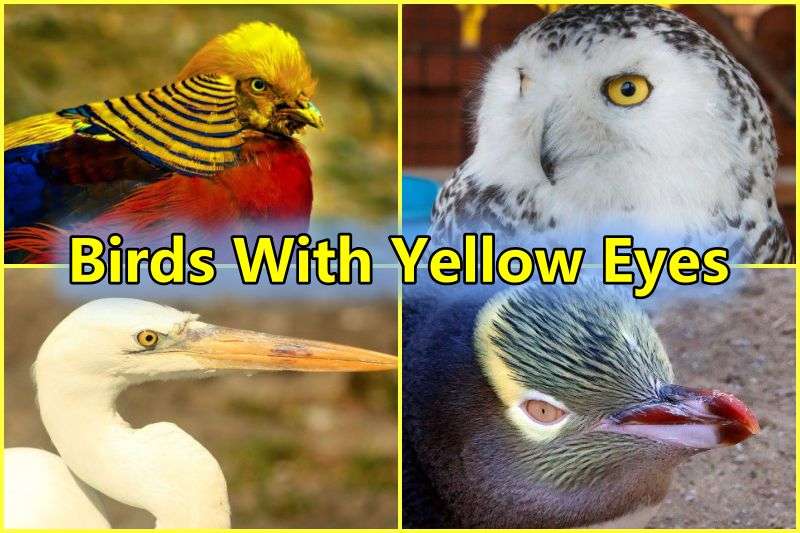Birds’ eyes come in a broader spectrum of colors than human eyes, from black to dark brown to white, yellow to orange to red, blue to green, and many other colors.
Interestingly, a bird’s eye color can change with age, gender, adaptability, and even the time of year it’s breeding. Birds with yellow eyes are one of the most beautiful creatures to sight on.
This article highlights the most exciting birds with yellow eyes, from the regal Bald Eagle to the bizarre Yellow-eyed Penguin. This guide not only provides fascinating information on these yellow-eyed birds and detailed descriptions of each species, but it also provides information on where to find them.
As chicks or adults, the following bird species have all been documented to have yellow eye coloration.
15 Magnificient Birds With Yellow Eyes On Earth
1) Golden Pheasant
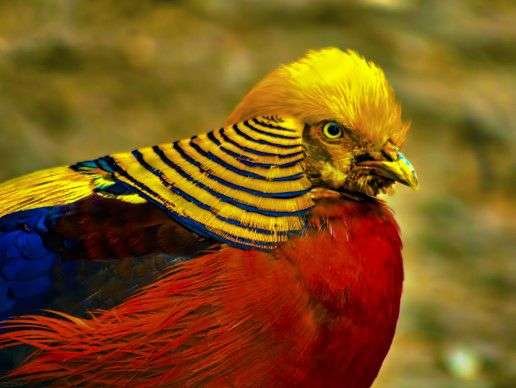
| Scientific Name | Chrysolophus pictus |
| Size | 20-45 inches |
| Life Span | 5-15 Years |
| Geographic Location | Western China, the UK, and North America |
| Diet | Seeds, fruit, insects, and small animals like snails and lizards. |
The tail is around two-thirds of the mature male’s length, 90-105 cm (35-41 in). Its vivid red body, golden crest, and rump make it easy to spot.
The bright yellow eye has a pinpoint black pupil, and the deep orange “cape” can be displayed to conceal the rest of the face.
An adult female measures between 60 and 70 centimeters (24 and 28 inches) in length and weighs about 350 grams. Males typically weigh between 500 and 700g.
The male’s crest is golden with a reddish tint at the very tip. Flesh on the face, throat, chin, and sides of the neck is rusty tan. The cape or ruff is a pale orange, while the wattles and orbital skin are yellow.
2) Snowy Owl
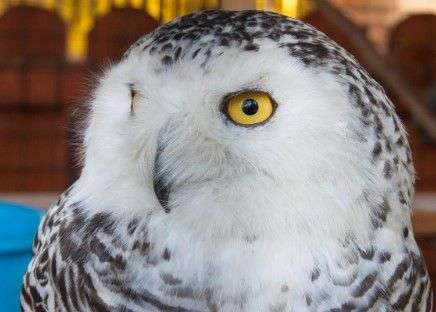
| Scientific Name | Bubo scandiacus |
| Size | 20-26 inches |
| Life Span | 10-20 Years |
| Geographic Location | Arctic Regions of North America |
| Diet | Lemmings, voles, and rabbits may also eat birds, fish, and insects. |
When spotted in the wild, these owls may be mistaken for a pale rock or a clump of snow. It lacks ear tufts most of the time, but the female, sitting on the nest, can raise tiny tufts that are likely vestigial.
The clumps of feathers in the ears range from 20 to 25 mm (0.79 to 0.98 in). Bright yellow eyes distinguish the snowy owl.
The Bubo owl has a simple ear and face disc because of its small size and the ease with which it has adapted to its environment.
One male had a tiny ear slit, measuring 21 mm 14 mm (0.83 in 0.55 in) on the left and 21 mm 14.5 mm (0.83 in 0.57 in) on the right. Females nearly always have a more subdued pattern than guys of the same age.
3) Red-tailed Hawk
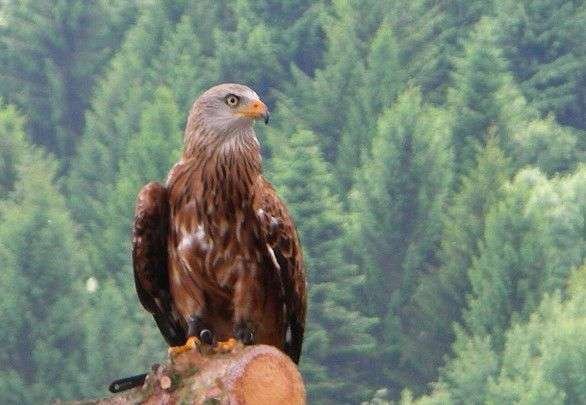
| Scientific Name | Buteo jamaicensis |
| Size | 18-26 inches |
| Life Span | 12-25 Years |
| Geographic Location | North America |
| Diet | Small mammals, such as mice, rabbits, and squirrels, will also eat birds, reptiles, and insects. |
The red-tailed hawk is a species of raptor found in the interior of Alaska and northern Canada, all the way down to Panama and the West Indies, where it nests. It is one of the most prevalent Buteo species in North America and elsewhere.
The heads of adult red-tails are typically brown at the nape and the top, creating a hooded appearance; however, some individuals may have a brighter brown “necklace” at the throat.
There is a possibility of dark brown spotting on the underside, more notably in juveniles and confident adults. The back is typically a shade deeper brown than the rest of the body, and the scapular feathers are noticeably lighter, ranging from tawny to white and making an uneven “V” shape.
This species’ mature males and females are easily identified by their distinctive tails, which have a buffed-out, bright orange color from below and a rusty, brick-red color up top.
4) Great Horned Owl

| Scientific Name | Bubo virginianus |
| Size | 18-25 inches |
| Life Span | 15-30 Years |
| Geographic Location | Throughout America |
| Diet | Rodents, rabbits, squirrels, skunks, snakes, fish, birds, and larger prey. |
Camouflage is a primary function of the great horned owl’s coloring. The upper body and upper wings are often a mottled brown with heavy, intricate, darker markings; the undersides are typically pale with some brown horizontal barring. All members of this species also include dark sidebars.
There is a white area on the throat, and its size varies. Even when the birds aren’t showing, the white throat may remain as a stripe down the center of the breast, and in white individuals, this streak may widen at the belly into a big white patch.
5) Cooper’s Hawk

| Scientific Name | Accipiter cooperii |
| Size | 14-20 inches |
| Life Span | 12-20 Years |
| Geographic Location | North America |
| Diet | Preys on other birds, such as doves, pigeons, and songbirds. |
For an Accipiter, Cooper’s hawk is of average size. Their wingspan is around average, their tails are long and graduated or even wedge-shaped, and their legs and toes are about average in length and thickness.
They have a short but powerful bill, and their eyes are usually situated far forward in the sides of a comprehensive and squarish-looking head (however, the head can look somewhat rounded if the feathers on the neck are held flush).
As is typical of raptorial birds, their beak is hooked and suited for shredding the flesh of prey.
6) Yellow-Eyed Penguin

| Scientific Name | Megadyptes antipodes |
| Size | 22 to 31 inches |
| Life Span | 10-15 Years |
| Geographic Location | New Zealand |
| Diet | Fish, including opal fish, red cod, and sprat. |
The Yellow-eyed Penguin, one of the world’s rarest penguin species, is endemic only to the eastern and south-eastern coasts of New Zealand.
The first thing you’ll notice about this Penguin is the ring of pale yellow feathers that circles its back. This rare Penguin has colorful plumage.
Black or slate gray with yellow dots can be seen on the animal’s forehead, chin, and cheeks. The body and tail are dark blue, while the flippers, chest, and belly undersides are white.
Red cod, blue cod, opal fish, squid, and sprat are among the favorite foods of these gorgeous penguins.
7) Common Goldeneye
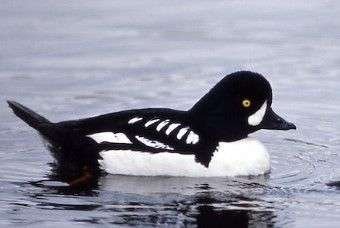
| Scientific Name | Bucephala clangula |
| Size | 15.8 to 20.1 inches |
| Life Span | 5-20 Years |
| Geographic Location | North America, Europe, and Asia. |
| Diet | Insect larvae, crustaceans, and mollusks. |
Often found in the boreal woods of Canada and Alaska, the Common Goldeneye is a diving duck that can withstand freezing temperatures. It spends the winters in Missouri. Therefore, if you want to see this beautiful species, search for it in huge groups on lakes and oceans.
Male Goldeneyes can be identified by their iridescent green triangular heads and distinctive white patch near their black bills. The majority of their bodies are white, but their backs are black.
A goldeneye’s eyes are a dull grayish brown during hatching, but by the time it’s five months old, they’ve progressed through purple-blue, blue, green-blue, and eventually pale green-yellow.
But, female Goldeneyes’ brown triangular heads and gray bodies set them apart. Black with yellow tips, their bills are unique among birds.
In mature males, the Common Goldeneye’s eye color eventually settles on a brilliant shade of yellow. Still, it gradually fades from a pale yellow to nearly white in adult females.
The Common Goldeneye’s food is incredibly varied, including aquatic invertebrates, fish, and fish eggs. It is common for them to dive to a depth of fewer than 13 feet while foraging for crustaceans, mollusks, insects, and even seeds, although they also frequent shallower waters when doing so.
Goldeneyes’ aggressive tendencies and ability to outnumber other duck species at a feeding place can be attributed to their enormous appetites.
8) Ring-Billed Gull
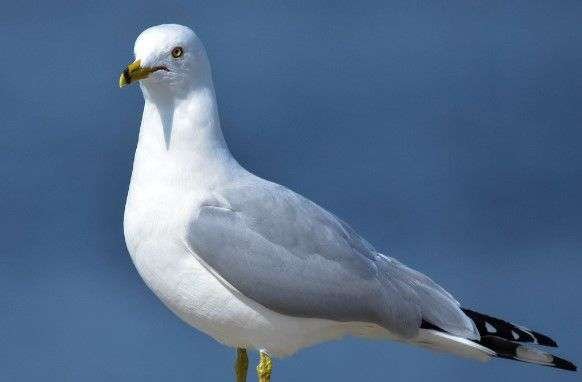
| Scientific Name | Larus delawarensis |
| Size | 16.9 to 21.3 inches |
| Life Span | 10-15 Years |
| Geographic Location | They breed in Canada, the United States, and northern Mexico in North and Central America. |
| Diet | Fish, insects, crustaceans, and small mammals. |
Compared to other gull species, the Ring-billed Gull is more likely to be found in inland locations. It’s one of the few bird types that has adjusted to modern life without our help.
They frequent beaches, docks, mudflats, cities, and farms. Massive roosting colonies of ring-billed gulls are familiar sights at sporting events.
These birds of the sea are aggressive and opportunistic omnivores that have acquired the label “fast food” gulls because they consume anything from fish and fruit to garbage and roadkill.
Their feathers are predominantly white, except for a pale gray back and a black tail. A black ring runs across the very tip of their yellow bills. The eyes of aging ring-billed gulls also shift from brown to yellow.
9) Bald Eagle
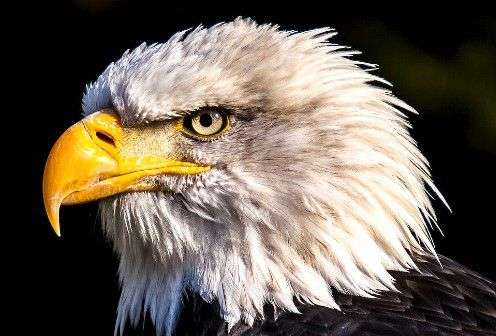
| Scientific Name | Haliaeetus leucocephalus |
| Size | 27.9 to 37.8 inches |
| Life Span | 20-30 Years or longer. |
| Geographic Location | North America, primarily in Canada and the United States. |
| Diet | Fish, although they will also eat small mammals, waterfowl, and carrion. |
Alaska is home to the most significant number of national birds, the Bald Eagle. Nonetheless, its habitat extends across the entirety of the United States, into northern Mexico, and throughout much of Canada.
These giant hawks would much rather avoid human interference and settle in the woods near large bodies of water. Because of this, a wide variety of fish makes up the bulk of their diet.
Bald Eagles consume various vertebrate and invertebrate animals, including birds, rabbits, reptiles, insects, turtles, and waterfowl, whether the food source is fresh, live, or dead.
10) Yellow-Eyed Junco
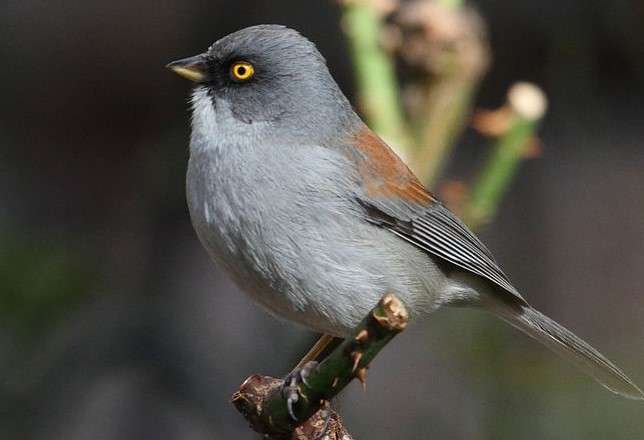
| Scientific Name | Junco phaeonotus |
| Size | 5.5 to 6.3 inches |
| Life Span | 4-8 Years |
| Geographic Location | Mexico and the Southwestern United States |
| Diet | Seeds, insects, and some fruit. |
The eyes of the Yellow-eyed Junco are yellow. Although these small New World sparrows have eyes that are more of a vivid yellow-orange, their sunlight-like brilliance can help you identify them in an instant.
Most of a Junco’s body is a bluish-gray tint, with a rusty red back and a white tail. Southern Arizona, New Mexico, and southern and northern Jalisco and Mexico are home to Juncos with paler undersides.
Although these small sparrows were originally from Mexico, they have since made their way to the mountains of Arizona and New Mexico.
They inhabit pine-oak and mixed coniferous woods between 5,300 and 10,000 feet in altitude. Usually resident in oak woodlands and fields, Yellow-eyed Juncos spend the winter months migrating downwards.
11) Osprey
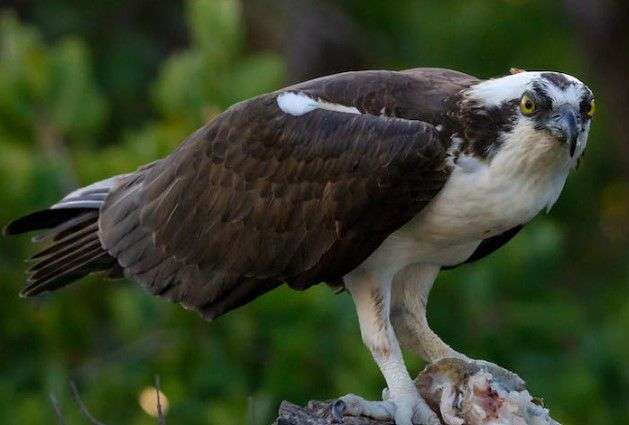
| Scientific Name | Pandion haliaetus |
| Size | 21.3 to 22.8 inches |
| Life Span | 7-20 Years |
| Geographic Location | Every continent except for Antarctica. |
| Diet | Fish. They may also eat small mammals, reptiles, or birds on occasion. |
In the realm of raptors, ospreys are so distinct that they warrant their genus. This species is especially unusual because it may be found in practically every part of the world.
This massive bird of prey has bright yellow eyes, a brown upper body, and a white underbelly. The white of its head stands out against the thick brown stripes that run from eye to neck.
Ospreys are okay with using manufactured buildings as nesting material. They also have no fear of humans, which may or may not be good news. Because of this, you should put up a nesting box before the mating season (usually January through May).
12) Brown Thrasher
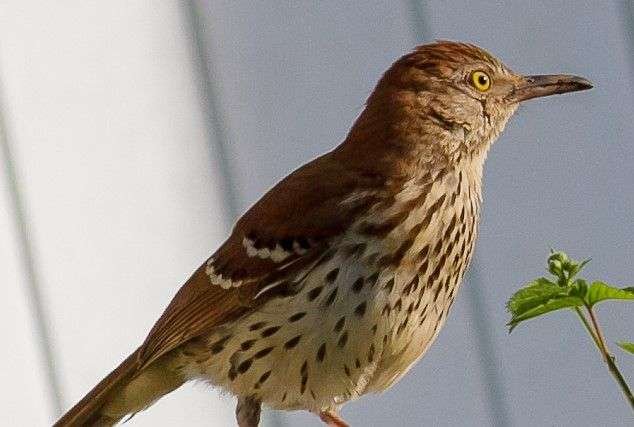
| Scientific Name | Toxostoma rufum |
| Size | 9.1 to 11.8 inches |
| Life Span | 3-11 years |
| Geographic Location | North America, Northern Mexico |
| Diet | Insects, worms, fruits, and seeds. |
These enormous songbirds, Brown Thrashers, have lengthy limbs, beaks, and tails. The male and female plumage is red fox brown with black streaks on the underside and black and white wing bars.
They also both have yellow eyes that stare intently. These hard-to-spot birds are most frequently seen in eastern North America. They favor dense covers, such as scrubby fields, forest borders, thickets, shrubberies, and thorn scrubs, where they may hide from predators.
Yet, they are audible while digging in the dirt for food. If you have a bird feeder or have berry-bearing bushes, they may also visit your yard. Although insects and arthropods comprise most of their food, they often consume berries, tiny fruit, seeds, and nuts.
Remember that despite being outstanding vocalists, Brown Thrashers may attack anything they perceive as threatening their nests, including people and dogs.
13) Lesser Scaup
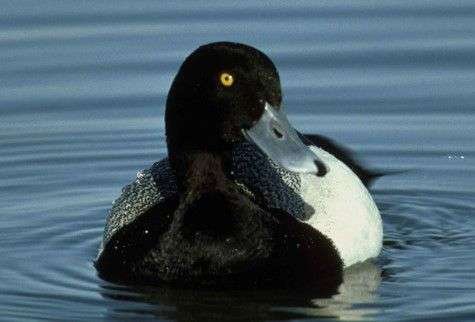
| Scientific Name | Aythya affinis |
| Size | 15.3 to 18.1 inches |
| Life Span | 5-13 Years |
| Geographic Location | Boreal forests of Alaska and Canada, and North America |
| Diet | Snails, clams, aquatic insects, small fish, and plant material. |
The Lesser Scaup is a medium-sized diving duck with a distinctive pale gray-blue bill, North America’s most common diving duck. Male Lesser Scaup has bright yellow irises that stand out against their iridescent purple-sheen-black heads.
Their fronts are black and white, while their backs are glossy black. The dark green mat can identify a flock of Lesser Scaups they create when they float on a body of water.
Yet, women’s eyes typically shift from olive brown to olive to brownish yellow. The remaining plumage is brown, but their heads are a deeper shade.
There is evidence that some female Scaups’ bill bases are white. This group of diving ducks is a year-round fixture on the world’s lakes, wetlands, reservoirs, and shorelines.
Throughout the breeding season and winter, they congregate by the hundreds or even the thousands in the prairie pothole region of the United States and the northern Canadian boreal forest and tundra zone.
14) Redhead Duck
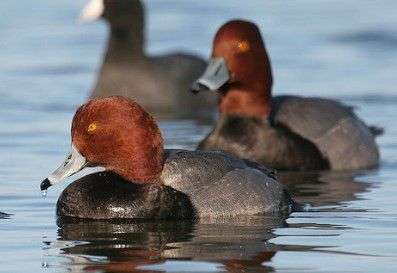
| Scientific Name | Aythya americana |
| Size | 16.5 to 21.3 inches |
| Life Span | 8-10 Years |
| Geographic Location | North America, including Alaska, Canada, and the United States. |
| Diet | Pondweeds, wild celery, widgeon grass, and small invertebrates, such as snails, clams, and insect larvae. |
The Redhead diving duck is a friendly creature that has lived in the central Mexican volcanic belt all year. Most Redheads gather in enormous flocks near the Gulf Coast for the mating season, the winter, and the migration.
Additional examples are the lakes, reservoirs, bays, and coasts of southwest Canada and the Lower 48. Like other pochards, redheads eat both plants and animals.
These crimson birds eat insect larvae, gastropods, and mollusks during the breeding and wintering seasons. But, they change to a plant-based diet, eating wild rice, musk grass, and wild celery.
Redhead men have yellow eyes, gray bodies, and black on their chests and behinds. Their foreheads are extremely slanted, and their bills meet at a sharp angle.
The female Redhead is a duller brown overall and has pale yellow eyes with a lighter brown patch at the base of the bill. Similarly, their foreheads are very high, yet the shift into the rest of their faces is very sudden.
Both male and female Redheads are about the same size and have similarly rounded, blue-gray bills with black tips.
15) The Great Egret

| Scientific Name | Ardea alba |
| Size | 37 to 40.9 inches |
| Life Span | 20-30 years |
| Geographic Location | North and South America, Europe, Africa, Asia, and Australia. |
| Diet | Fish, amphibians, reptiles, insects, and small mammals. |
The Great Egret is a species of heron that may be found in many parts of the world. These birds are distinguished by their long, S-shaped necks, yellow eyes, and long, leggy white bodies.
Male and female Great Egrets get their common name, “Egret,” from the long, flowing plumes (called “aigrettes”) that grow from their backs and coil around their tails during the breeding season.
Moreover, a lime green splotch appears between their eyes and bills. However, more than the Great Egret’s plumage alone is needed to tell it apart from other egrets. The heron stands out due to its massive size and long, sooty black legs.
This beautiful bird is most prevalent in the southern United States but can be found as far north as Massachusetts in fresh and salt shallow marshes.
They are wading birds like Great Egrets, like external bodies of water for hunting. Therefore they are commonly spotted in marshes, ponds, and coastal mudflats. They may search for grasshoppers and rodents.
Conclusion
Not all birds have blue or brown eyes; ducks, penguins, and raptors, for example, might have yellow eyes. Yellow eyes may be present at birth in some species, whereas they may appear later in life in others. Whatever the case, a bird’s brilliant yellow eyes can tell you a lot about its age, species, gender, and even personality.
Also Read:

A writer who studied agriculture. Nature has always drawn me in, and my main goal in writing about it is to discover some of its secrets. You can usually find me reading Bengali and English masterpieces or filling the room with lovely music if I’m not engrossed in nature or anime material. I adore playing the guitar. I’m also that friend of yours who enjoys playing video games.
